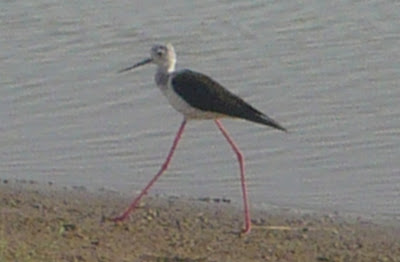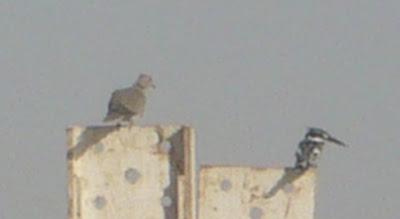To the average birder, there are some birds that we tend to see as worth little more than a tick mark on the checklist. They tend to be a given, they are common, they may even be introduced (that is, not a native species). Depending where you are, they vary, but they are birds like Mallards, European Starling, Rock Pigeons, and, of course, the ubiquitous House Sparrow Passer domesticus.
They are found on all 6 inhabited continents. To say that these little feathered creations are controversial is an understatement. Ornithologists can't decide if they are related to Weaver Finches or some other family. Conservationist consider their introduction into North America and Australia a huge mistake. They are aggressive cavity-nesters and compete (quite successfully) with many native species.
They are considered the most abundant bird on the planet, however. They thrive in areas where man has altered the landscape. Walk into almost any large retail store with a warehouse-type ceiling and you will probably find some. Lately, I have been amazed just to see them in the deserts of Kuwait and Iraq. They find our camps, our outposts, and they manage to live off the water we spill and the food we drop, or so it seems.
I was bemused to see one today perched underneath the exhaust vent on a shower trailer, trying to stay cool. No easy task, with the temperature hovering around 116 and a firm breeze creating the effect of having a hair dryer pointed at you while sitting under a heat lamp.
Yes, I understand there are lots of issues around this species. But largely, they are not its fault. They did not ask to be crated up and sent around the globe in centuries past. They just did what they always did once they were released. And they do it well: adapt, overcome and survive. So even if the reasons to dislike them are long, they still deserve a measure of respect as being, in terms of numbers and range anyway, the biggest bird in the world.
Birds, dragon and damselflies and other natural (mostly winged) wonders, and the thoughts they inspire in me.
24 June 2008
21 June 2008
In Asia, Again....
Well, after 364 days stateside the Army decided that, once again, I should go birding in Asia on their dime. This time, though, it's southwest Asia, aka Iraq.
So far the birding hasn't been too bad. Kuwait only netted 2 birds, House Sparrow (it there anyplace they don't live?) and Crested Lark. Mostly, Kuwait was a non-stop sandstorm for the 5 days I was there.
Now that I am in-country, the sand storms have subsided and birding has picked up. On the FOB I am on right now, we are blessed with a small pond. This, of course, is a bit of a bird magnet, which suits me just fine. The past two mornings I have spent some time birding around it before breakfast.
Just having some open water, having that wonderful fresh water lake smell, takes me back to the Midwest in the states. It is incredibly refreshing, dare I say, on a spiritual level. But then, God has wooed me through nature for most of my life.
Well, toting around my pocket camera, I managed a few pictures this morning where you can actually tell they are birds...I'll share a few.
Here is a Black-winged Stilt that I watched for quite a while this morning.

Eurasian Collared Dove and Pied Kingfisher.

And then a picture of a White-cheeked Bubul from yesterday taken near the chow hall.

I also saw a Snowy Plover, Common Sandpiper, Crested Lark and the ever-popular Rock Pigeon. Finally, an interesting bird that frequents the pond is the Red-wattled Lapwing. This is a large plover-like bird with a striking tan, white and black plumage and yellow legs. It likes to fly around calling out "did-he-do-it, did-he-do-it, did-did-he-do-it" rather loudly. Unfortunately, they don't stay still long enough, near enough for me to get a picture yet. It's gets its name because it has a red eye-ring that has a little bit extra (the "wattle") toward the front. It's not terribly easy to see, but it makes for a good name, I suppose.
So far the birding hasn't been too bad. Kuwait only netted 2 birds, House Sparrow (it there anyplace they don't live?) and Crested Lark. Mostly, Kuwait was a non-stop sandstorm for the 5 days I was there.
Now that I am in-country, the sand storms have subsided and birding has picked up. On the FOB I am on right now, we are blessed with a small pond. This, of course, is a bit of a bird magnet, which suits me just fine. The past two mornings I have spent some time birding around it before breakfast.
Just having some open water, having that wonderful fresh water lake smell, takes me back to the Midwest in the states. It is incredibly refreshing, dare I say, on a spiritual level. But then, God has wooed me through nature for most of my life.
Well, toting around my pocket camera, I managed a few pictures this morning where you can actually tell they are birds...I'll share a few.
Here is a Black-winged Stilt that I watched for quite a while this morning.
Eurasian Collared Dove and Pied Kingfisher.
And then a picture of a White-cheeked Bubul from yesterday taken near the chow hall.

I also saw a Snowy Plover, Common Sandpiper, Crested Lark and the ever-popular Rock Pigeon. Finally, an interesting bird that frequents the pond is the Red-wattled Lapwing. This is a large plover-like bird with a striking tan, white and black plumage and yellow legs. It likes to fly around calling out "did-he-do-it, did-he-do-it, did-did-he-do-it" rather loudly. Unfortunately, they don't stay still long enough, near enough for me to get a picture yet. It's gets its name because it has a red eye-ring that has a little bit extra (the "wattle") toward the front. It's not terribly easy to see, but it makes for a good name, I suppose.
Subscribe to:
Posts (Atom)
